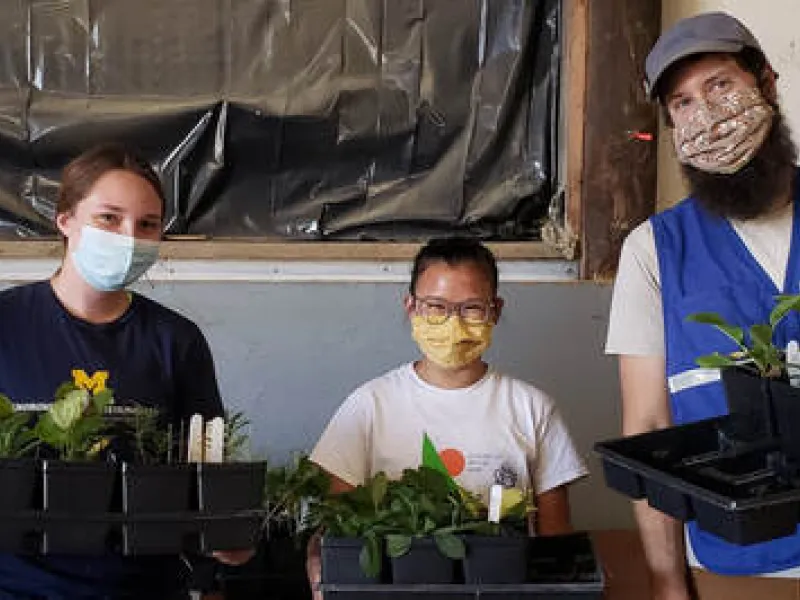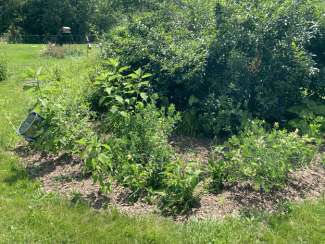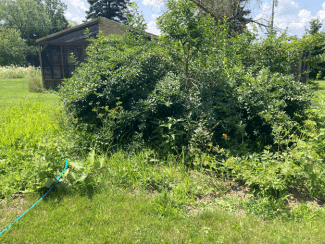Bird Center of Michigan
Habitat Sanctuary

The Bird Center of Michigan was he first WCCD School & Community Habitat Grant project to wrap up in 2021. It was led by the determined team of Aude and Ashley, both landscaping architect students at University of Michigan. They got involved with the Bird Center of Michigan as a Practicum Project of their Masters' program requirements. The goals of the project were to replace lawn and non-native landscaping with a naturalized planting design, to provide habitat for birds that are released after being cared for at the center.
Previous to applying for the grant, they had already established new native plant beds adjacent to the Bird Center of Michigan's building. The WCCD grant enabled them to take on another section of the property, transforming lawn and old landscaping to become a new native plant garden. Through the grant, they received native plants that the WCCD sourced from Designs By Nature nurseries in conjunction with the WCCD Fall Tree & Native Plant sales.
Continue reading for the project reports and before/after photos!
2023 Project Report: Bird Center of Michigan
Audeline Kurniawan and Ashley Truitt
July 25, 2023
The Bird Center of Michigan is very happy with our new native landscape, despite a few challenges we have had with the garden. A majority of the native plants can be found throughout the garden, but we have been struggling to keep up with the weeds encroaching on the southern half of the planting area. After planting in the fall of 2021, the following summer we weeded the entire garden frequently and re-mulched to try and stay ahead of the weeds. In 2023, we have weeded once monthly since April, twice with volunteer groups and once with a contract gardener. Unfortunately, the southern half of the garden is still being overtaken by weeds, and we fear some of the native plants were accidentally pulled by our volunteer groups. We wonder if the proximity of the bird feeder area to the garden has impacted the amount of weeds.
Moving forward, we are likely going to condense the garden to just the northern half, transplanting any visible native species from the south to increase the planting density and hopefully reduce the overall weeds in the bed. We will also prune back the large existing forsythia bush, as it has grown quite a bit within the last month, and continue to mulch as necessary.
Overall, we are beyond pleased with our native garden at the Bird Center. It is a great resource for our songbirds and pollinators, and cannot wait to continue to see it grow and flourish! Thank you WCCD for the generous resources and guidance.

Northern half of the garden, native plants are establishing and growing well. Can see the weeded area toward the back of the photo.

Southern half of the garden is on the left of the photo. The weeds have encroached on the natives that were planted.

Northern half of the garden, native plants are establishing and growing well with a few stray weeds. The existing forsythia needs to be trimmed back.
Above is their Practicum Project final presentation, rich in information outlining their project. Thanks to Ashley & Audi for the work and permission to share this presentation!
2021 Project Report
by Audeline Kurniawan, Ashley Truitt
10/25/21
Installation
Installation went smoothly, as both Practicum Project members (Audeline and Ashley) have past experience in planting design, prep-work, and installation of perennial gardens. We made plant choices first based on what was available through the WCCD grant, then outlined a
relatively simple design for the backyard of the Bird Center’s new property. We drew out matrix blocks, which is consistent with the front yard’s design, and combined plants within the blocks that would complement each other in resources provided to birds, bloom color, and bloom time.
We then coordinated a day that worked for the Bird Center, they created an event on their facebook page, and we reached out to colleagues through email and social media to recruit volunteers for the planting day. In the meantime, Ashley and I prepped the chosen area
for planting. We used tools borrowed from K.C. Runciman Landscapes, who we have both worked for in the past (full-time) and currently (part-time). We measured and marked the garden bed outline with orange flags and yard-friendly spray paint, then we used various tools to remove the overgrown invasives, weeds, and sod within the marked area. We also pruned back the overgrown existing Forsythia shrub to lessen it’s large footprint. In addition, we removed embedded logs that had marked the previous bed, and re-graded the area to gently slope with the rest of the yard.
On the planting day, we used the same yard-friendly spray paint to mark the matrix blocks and set out the appropriate plants within each of the blocks at a predetermined distance from each other to maximize a “full” and natural appearance. From there, it was simply getting
the plants in the ground and mulching with a shredded hardwood mulch! Mulch is utilized to discourage the growth of weeds and other invasives. Although weeds will still grow, the mulch helps to prevent and slow this process down. It also helps to lock moisture in during especially dry and hot days once the plants have been watered thoroughly by hand or with a sprinkler.
Challenges
We didn’t encounter too many challenges with this project, but we will mention a few obstacles we had to overcome. Plant choices can be tough when you have a vision in mind and then need to adjust the design according to what is available in nurseries at the time. This past
season has been understandably difficult for many industries, including landscaping and design, due to many factors like people coming back to the workforce after more than a year of remote-work and having to catch up to the demand. This can be a more difficult issue to tackle in the realm of private yards where clients want very specific plants, so we were happy to have the flexibility in our design and still be able to fulfill the Bird Center’s needs.
Another challenge was coordinating a day that would work for volunteers to come and help us plant. With many things being back “in person” now, we know that people are trying to take advantage of the nice weather days to travel and do fun things before the winter hits. Thus, we had less people volunteer than expected, but it all worked out in the end and we were still able to finish the planting in one day.
Plan for the First Year
Due to the planting being done in the fall and given that temperatures are starting to drop, we are currently watering the plants as needed and checking on them weekly to make sure they are still doing well. Later in the fall and in the spring, we will need to remove weeds so
the plants do not get choked out and have a better chance of establishing. When temperatures start getting warm for the summer, we will ensure that the Bird Center has a regular schedule for watering the plants. There is a timer and a sprinkler head that can be set up for easy watering.
As part of our practicum project, we will be creating a management plan for the Bird Center. This will outline all of these protocols and provide assistance for scheduling volunteer days to take care of the maintenance.
See the pictures below for the transformation!





